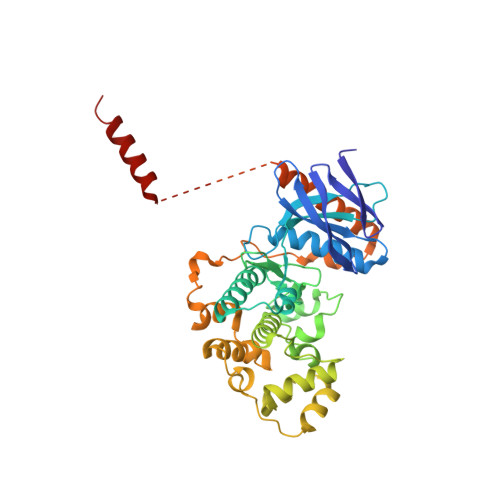Structure-Aided Identification of an Inhibitor Targets Mps1 for the Management of Plant-Pathogenic Fungi.
Kong, Z., Zhang, X., Zhou, F., Tang, L., Chen, Y., Li, S., Zhang, X., Kuai, L., Su, W., Cui, W., Cai, J., Wang, Y., Yang, J., Peng, Y.L., Wang, D., Liu, J.(2023) mBio 14: e0288322-e0288322
- PubMed: 36779710
- DOI: https://doi.org/10.1128/mbio.02883-22
- Primary Citation of Related Structures:
8H59 - PubMed Abstract:
Blast disease caused by Magnaporthe oryzae threatens rice production worldwide, and chemical control is one of the main methods of its management. The high mutation rate of the M. oryzae genome results in drug resistance, which calls for novel fungicide targets. Fungal proteins that function during the infection process might be potential candidates, and Mps1 (M. oryzae mitogen-activated protein kinase 1) is such a protein that plays a critical role in appressorium penetration of the plant cell wall. Here, we report the structure-aided identification of a small-molecule inhibitor of Mps1. High-throughput screening was performed with Mps1 against a DNA-encoded compound library, and one compound, named A378-0, with the best performance was selected for further verification. A378-0 exhibits a higher binding affinity than the kinase cosubstrate ATP and can inhibit the enzyme activity of Mps1. Cocrystallization of A378-0 with Mps1 revealed that A378-0 binds to the catalytic pocket of Mps1, while the three ring-type substructures of A378-0 constitute a triangle that squeezes into the pocket. In planta assays showed that A378-0 could inhibit both the appressorium penetration and invasive growth but not the appressorium development of M. oryzae, which is consistent with the biological function of Mps1. Furthermore, A378-0 exhibits binding and activity inhibition abilities against Mpk1, the Mps1 ortholog of the soilborne fungal pathogen Fusarium oxysporum. Collectively, these results show that Mps1 as well as its orthologs can be regarded as fungicide targets, and A378-0 might be used as a hit compound for the development of a broad-spectrum fungicide. IMPORTANCE M. oryzae is the causal agent of rice blast, one of the most devastating diseases of cultivated rice. Chemical control is still the main strategy for its management, and the identification of novel fungicide targets is indispensable for overcoming existing problems such as drug resistance and food safety. With a combination of structural, biochemical, and in planta assays, our research shows that Mps1 may serve as a fungicide target and confirms that compound A378-0 binds to Mps1 and possesses bioactivity in inhibiting M. oryzae virulence. As fungal orthologs of Mps1 are conserved, A378-0 may serve as a hit for broad-spectrum fungicide development, as evidenced with Mpk1, the Mps1 ortholog of F. oxysporum. Additionally, A378-0 contains a novel chemical scaffold that has not been reported in approved kinase inhibitors, suggesting its potential to be considered the basis for the development of other kinase inhibitors.
Organizational Affiliation:
Ministry of Agriculture Key Laboratory for Crop Pest Monitoring and Green Control, College of Plant Protection, China Agricultural University, Beijing, China.















